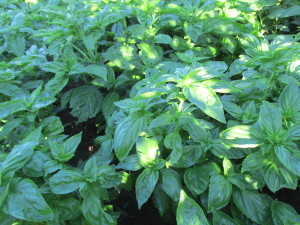Availability, Nutrition, and Recipe Suggestions
In Season: Basil season is never long enough due to the relatively recent incursion of Basil Downy Mildew as an annual affliction. Fresh basil harvests start in June, are heaviest in July (a good time for making pesto), and continue in limited quantities into the early fall if we are able to hold back the mildew.
Storage: To keep basil fresh, trim the stems and place them in a glass or jar of water, just like cut flowers. Loosely cover it with a plastic bag and leave it on the counter. Although certain herbs, such as parsley and cilantro, can be stored this way in the fridge, basil does better at room temperature. If not Fresh basil should be stored in the refrigerator wrapped in a slightly damp paper towel.
Preservation: Here are 3 ways to preserve your basil. Freeze the leaves whole, puree then freeze, or drying them. [thekitchn.com] Also check out the recipes below you can freeze your pesto for long term storage.
Production Notes: Not so very long ago, we could reliably grow basil until frost… not so easily done thanks to a dramatic expansion in the range of basil downy mildew. As breeders work to grow more resilient varieties we should gradually start to enjoy fall harvests of basil again. As a rule basil is abundant in late June into early July before mildew arrives.
Varieties: While Italian Large Leaf is still our go to for early production, its susceptibility to mildew has pushed us to trial other varieties… Eleonora and Everleaf provide moderate resistance and additional commercial varieties will be released which we’ll seed in 2019.
Nutrition: Basil is an excellent source of vitamin K and manganese; a very good source of copper, vitamin A (in the form of carotenoids such as beta-carotene), and vitamin C; and a good source of calcium, iron, folate, magnesium and omega-3 fatty acids. [whfoods.com]
Deep Nutrition: Basil is high in vitamin K, which is essential for blood clotting. Just two tablespoons of basil provides 29 percent of the daily recommended value. [foodfacts.mercola.com]
Deep Science: Basil also has antibacterial properties and contains DNA-protecting flavonoids. It’s the flavonoids and volatile oils in basil that give it the most health benefits, the former protecting on the cellular level, with antibacterial properties related to its volatile oils. [foodfacts.mercola.com]
Preparation: Basil should be removed from the stem and added in the last minutes or seconds of any cooking.
- Fresh Basil Pesto [simplyrecipies.com]
- Basil Cucumber and Watermelon Salad [foodiecrush.com]
- Zucchini Latkes with Parmesan, Pine Nuts, and Basil [seriouseats.com]
- Braised Eggplant with Garlic and Basil [seriouseats.com]
Basil Pairs well with — Garlic, eggplant, tomatoes, olive oil, meats, lemon, salmon, eggs, watermelon, and zucchini.
Yum.
authored by: Danny Guillotte and Derek Christianson
Updated February 2019
